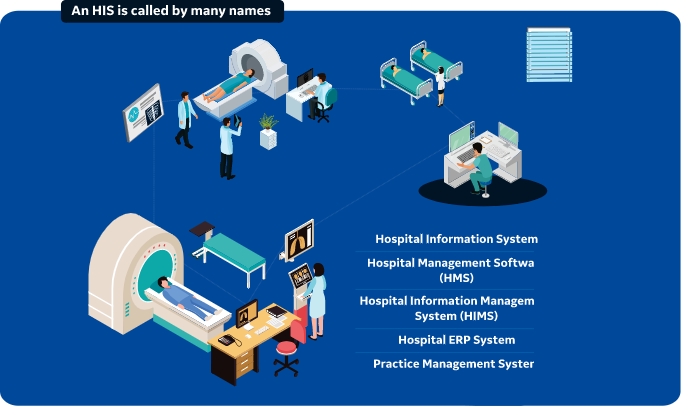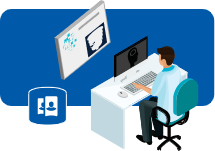
The COVID-19 pandemic has drawn much public awareness to the importance of health. While the lndian Healthcare Market was already growing, it has been propelled further forward, exceeding $350 billion by 2022. This is partly driven by increasing digitization in healthcare
In India, corporatized healthcare coexists happily with government healthcare, and there are many options between these two polar extremes Corporate hospital chains such as the Apollo, Fortis, Manipal and Max groups have Chief Intormation Officers (CIOs), who are actively involved in managing not only the HIS, but also the hospital's digital strategy. These hospitals recognize that managing information is an investment.They have large IT departments, and deal with a myriad of digital health providers. The Government of India has made a massive push towards digitization through the National Digital Health Mission (NDHM). They envisage a unique health ID for all (like the NHS), and patient data being portable across an information highway which connects with all HIS/ EMR systems in India. India has a large telemedicine network. created in public private partnership. More patients are seeking out remote consultation options, so that they can receive care faster. With both government and private health insurance schemes prevailing in India, it has become critical to relay information to insurance companies, so that claims can be processed.
Quality accreditation (NABH/ NABL/ JCI) is used as a differentiation tool by many hospitals, and this is difficult to achieve without digitization. Healthcare in India also tends to be partly patient led, with increasing awareness of health, and individual health tracking using apps and wearables. With this backdrop, the digitization of a hospital or a practice will become essential The HIS, or Hospital Management Software System, is the first building block to ensure that your hospital or clinic is digitized.
HIS or Hospital Information System is a software system which manages the journey of a patient through a hospital while tracking the transactions and costs which occur as a part of this journey.

These terms apply to versions of the same software An application which helps to run Hospital operations, while managing its revenues, staff, equipment, and resources is a Hospital Information System. The focus of any HIS should be to reduce turn around times, track costs and revenues, manage sensitive hospital data, and generate management reports which aid in decision making.

Cost "leakage" is a frequent problem in most hospitals. There are large stores, and smaller substores. In a traditional pen and paper system, this stock is tracked upto the substore level. However, it is unrealistic to expect the nurse to note down every piece of gauze or every crocin tablet that is used for a patient.
A good hospital information system would have an indent system, where stock is issued directly to a patient. The system would track this stock from the time that a purchase order for it is placed on the vendor. The system would assign older stock before newer stock, so that medicines close to expiry are prescribed first, resulting in significant savings. Most of this is a one time setup exercise, and it makes stock management a seamless and transparent process.
Each item is now trackable, so theft and loss are significantly limited.
With more internatianal patients visiting India for treatment, and stiffer competition among hospitals, particularly in cities, accreditation is becoming more common. Accreditation serves as a stamp that a hospital laboratory offers a certain standard of care. It is virtually impossible to get accredited without having a software system in place.


Cost "leakage" is a frequent problem in most hospitals. There are large stores, and smaller substores. In a traditional pen and paper system, this stock is tracked upto the substore level. However, it is unrealistic to expect the nurse to note down every piece of gauze or every crocin tablet that is used for a patient.
A good hospital information system would have an indent system, where stock is issued directly to a patient. The system would track this stock from the time that a purchase order for it is placed on the vendor. The system would assign older stock before newer stock, so that medicines close to expiry are prescribed first, resulting in significant savings. Most of this is a one time setup exercise, and it makes stock management a seamless and transparent process.
Each item is now trackable, so theft and loss are significantly limited.
The HIS minimizes human error and increases transparency particularly in billing. When you set up a new hospital, you have so many questions

Creditors: What information do I need to send to the TPA? What are my outstandings from CGHS? ShouldI even take ESIC patients? How long does Star Insurance take to clear my bills?
Discounts: Who is authorized to give a discount in my absence? Can see I what discounts have been given?
Patients Bills: How do l know if a patient's advance has been exhausted? How should I change billing rates when patient decides to move from general ward to single room after his surgery? I've changed my billing rates, do l have to retrain all my billing personnel?
I sent some tests out to an external laboratoryhave these been incorporated into the patient's bill?
The answers to these questions and many others lie in a robust HIS
take to Management of the different rates and nuances of these billing systems is virtually impossible without a good HIS. Having dependency on human input in this

The digital medical record of a patient is known as an EMR or electronic medical record. While EMRS range from simple to complex, they are becoming an indispensable part of the HIS. At the very least, the care giver should be able to order and view tests, create charts, order medication (e-prescription on CPOE) and refer a patient for admission, surgery or further care. An advanced EMR would integrate with a Drug Database and offer Clinical Decision Support.
Desktop based applications are the old guard of HIS applications. These are usually robust, fast and stable, and are not dependent on an internet connection. However, implementation is lengthy, as these need to be installed individually on each computer in the hospital. Each PC needs to have a certain minimum configuration (which tends to drive up hardware costs). If a computer crashes, the HIS on that computer crashes along with it. The license would need to be reinstalled on a fresh computer. Service patches need to be deployed individually on all machines, and service is expensive. Desktop based applications usually fail if you need to run a network of hospitals, as these do not support multilocational functionality.
Web based hospital software systems run on an internet connection. These can be either hosted on a server in the hospital premises, or on a cloud (remote server). If they are hosted on the premises, these run on your LAN (Local Area Network)and can be accessed from outside the premises using an internet connection. LAN based deployments are extremely secure, with patient data remaining inaccessible as long as server ports are kept closed. With more hospitals opening branches and clinics, web-based applications are becoming commonplace, as these support multilocational functionality. These are quick to implement, easy to service and can be run off a basic internet connection. These can be accessed from outside using a userlD and password, so that you can always be connected to your patients.
A Cloud based HIS is simply a web based HIS which is hosted on a remote server. Your vendor will take care of deploying the HIS (you will not have a server in the hospital), and you will access it through an internet connection.
This is an attractive proposition, because you are saved the hassle of having to buy a server, install LAN, and maintain both. You would pay a monthly charge to your service provider for the usage of the Hospital Management Software.
However, keep the following in mind:
- The security of your patient data is your liability. Make sure the provider is hosting your data on a secure service such as Amazon Web Services (AWS) or Microsoft Azure. Data loss would be catastrophic for your organization.
- Ensuring that internet is working 100% of the time is your responsibility. Make sure that you have a fast connection, and a back up line. If the internet becomes slow or goes down, your software goes down with it, and all transactions in your hospital come to a standstill
- While cloud based providers have attractive pricing models, make sure you look at the total cost of ownership. See what the solution will Cost you over 3 years or 5 years - the total cost may surprise you.
An HIS will allow you to register a patient in the hospital, print a patient ID card, allow you to schedule appointments for doctors as well as diagnostic tests, and cancel or reschedule these, as necessary. More advanced systems will also provide a Patient Portal and Mobile Apps, which allow the patient to register, schedule appointments, perform a teleconsult, and even pay online.
A hospital software will allow you to generate a consultation for a patient, create a prescription, make bills and collect payment for consultations, laboratory tests, radiology investigations and outpatient procedures. A good HIS will give you multiple payment modes, including credit, cash, wallet, point of sale, etc. It will also allow you to manage discounts, cancellations, and refunds, and will give you duplicate bills, if a patient loses his bill.
It will also allow an Admissions desk user to see which beds are free, and allow them to admit patients
Billing for admitted patients is significantly more complex than outpatient billing. Most hospitals will give their patients an estimate of the cost of the procedure, prior to admission. A good HIS will enable both the estimation process, alert the user to collect advances, on a periodic basis. Patient transfer, surgery or discharge will not be possible without billing approval.
Insurance claims in India are managed by TPAs (Third Party Administrators)or Corporates. A hospital software system will allow you to empanel TPAs, Corporates or Insurance Companies. It will also help you set up corporate pricing, discounts and co-payment options. It will allow you to track Preauthorization approvals, send bills to TPAs or Corporates and track payments.
Specific tariffs and formats, such as those applicable for CGHS, ESIC, Ayushman Bharat PM-JAY are also managed to ensure that users do not make errors.
If you have an in-house laboratory, a laboratory module, or a Laboratory Information System (LIS) is a must. This should allow you to collect barcoded samples from anywhere in the hospital or form a sample collection center It will allow you to reject a hemolyzed or insufficient sample. It should allow you to enter test results or communicate directly with autoanalyzers where possible.
The system will allow you to set reference ranges and create reports both autogenerated and manually created as per a template. Reports will be digitally signed and printed. In some systems, the prescribing physician would be sent an alert (via text or email), if a patient has alarming values, so that he can provide care immediately
Tests which are referred to an external laboratory can also be tracked.
If you run your diagnostics in-house, a RIS PACS solution is the order of the day. A RIS is a Radiology Information System. This is often integrated with a PACS (a Picture Archival and Communication System). The RIS helps you to schedule radiology appointments, generate templatized reports, digitally sign reports, give prescribing physicians the option to access their patients reports, and track their dispatch and disbursal. Most HIS companies provide only the Radiology Information System, but some will integrate with a PACS of your choosing
A PACS System deals with the radiology image piece it allows you to view radiology images from a workstation anywhere within or outside the hospital. It allows you to delve deeper into images, by zooming in or out, rotating. flipping or changing the axis. Some PACS systems come with integrated Artificial Intelligence, which allows for intelligent reporting.
The Emergency Room/ Casualty of your hospital needs specific functionality. Your HIS will allow you to register patients with minimal information, triage them, register a medicolegal case, and provide emergency services without an indent process. It will also allow you to discharge a patient directly from the emergency, refer him to admission, or label him as brought dead, Billing services can be rendered there and then, and an ambulance or a mortuary request can be sent.
HIS applications may come with or without an inbuilt EMR. An EMR is a digital version of your patients' files. EMR is the sum of many moving parts -the patient's investigations, his outpatient record, nursing notes, physiotherapist's notes, etc.
However, in India, it is seen to be composed primarily of the Doctor's Module.
In the Doctor's Module, a doctor sees what his OPD looks like- how many appointments, how many patients waiting. He is also able to create a prescription, prescribe tests and prescribe radiology investigations this information is sent directly to the various hospital departments He is also able to request admission and schedule surgeries. For his admitted patients, he should be able to login and view a list of patients admitted under him, add progress notes, see investigation results, view nursing charts, generate a templatized discharge summary and discharge the patient. He may also see what his earnings are for the month and compare this to previous months.
He will see the patient's past history and refer him to another doctor for their advice.
Nursing, also called Inpatient Management is a part of the HIS which allows nurses to provide seamless, quality care to admitted patients. A nurse is able to allocate a bed, transfer a patient, request a service (be it an investigation, a procedure, blood or surgery), create charts (intake, blood glucose, insulin, vitals, etc.). She can also handover a patient at shift change or initiate his discharge.
This module is critical for any hospital performing surgeries. Multiple resources need to be assigned if a surgery is scheduled the surgeon, operating room, specialized equipment, the anesthesiologist, CSSD trays, linen, etc. A good hospital management software will align these perfectly, so that waiting times are minimized. The system will also carry all your checklists and essential forms, so that they can be filled either electronically or in hard copy, by taking a printout. OT records and surgery notes can also be entered into the system.
Hospitals are massive consumers of different types of materials, as varied as vacutainers, syringes, gauze, medicines, housekeeping supplies, detergent, surgical equipment, trays, etc. Hospitals spend both time and money on purchase, and it is crippling when supplies are pilfered, misplaced, or expired.
This portion of the HIS helps to manage the hospital purchase, consumption and stock management process. It creates purchase orders, receives goods, sets expiry dates and sets reorder levels. It allows wards and outpatient departments to interact with the stores and pharmacy department, by allowing an indent process and managing departmental consumption.
Multiple reports should be generated which allow the hospital to manage consumption and costs better.
The Management Information System is an integral part of any hospital information system. CXOs view a Management Dashboard that helps them identify areas that need improvement. They also view several detailed reports, which are critical to properly track and manage a hospital.
This module allows a hospital administrator or IT person to set up/ make changes in rates, reference ranges, procedures, templates, employees, etc. A good System Administration Module allows a hospital to make changes in its system as required, without having to go back to the software provider.
There are many other modules that Hospital Management Software Companies offer today, depending on the complexity of your hospital. Some of these can be purchased from different standalone providers, while some are an integral part of the HIS. These include:

Are the doctors in your hospital digitally savvy? Do you aspire to run a paperless hospital? Do you need digital copies of all your records? If the answer to any of these questions is yes, you need an EMR. EMRs are diverse in their variety, and in the promises they make.
Healthcare processes in India are still not standardized. Vendors need to customize their applications based on the hospital's needs. A company with more clients and a variety of clients (a mix of small, big, government, private, chains and standalone hospitals) will have wide experience, and will be able to implement faster Look for a company which has at least 50 clients. Ask to see testimonials and proof of Go- Live.
Service is a key component of any software installation. See if the provider has a ticketing system and ask them about their service strategy. Look to see how long they've been able to retain clients. Client retention over 7 years is a plus.
There are more than 200 HIS vendors in India. Some are local, others have national presence. In the face of this mind-boggling variety, we have compiled a list of questions which will help you decide which system to buy, based on answers to the questions below:.
Can everyone see all parts of the HIS or can a user only see portions relevant to him? Ideally, a front desk manager should see only front desk information, and a doctor should be able to see only those patients which are admitted under him. All of this is defined by access rights. Look for a system with good user access security. Ask the vendor to login as different users to show you different views.
The System Administration Module gives you control over the variables in your own software without having to call on the vendor for every change in the rate list. The masters should be comprehensive, easy to set up and use.
How are key cost areas handled? Look for systems with robust billing, pharmacy and material management modules - these will make the biggest difference to managing your costs and revenues. Look for a few key reports, such as ABC (Activity Based Costing), Outstandings, etc.
Do you have more than one location for instance, do you run a hospital and a clinic, which are geographically separated? Do you run a hospital chain? Are you planning to expand to a new location in the future? If the answer to any of these questions is yes, you need a software which is multilocational. Ask the vendor to share details of previous multilocational implementations.
The COVID-19 pandemic has pushed the need for hospitals to engage with their patients more - through mobile applications, a patient portal, or teleconsultation services. Assess to see if these are important for you. You HIS vendor may either provide this himself or in integrate with someone else who does.
Where is their development center? How many people do they have? Do they have a separate testing team?
The user interface applies to the look and feel of the software. Is it attractive and easy to use? Have the developers tried to minimize clicks to save time?
The technology that the provider uses for development has hidden cost implications for the hospital Databases like MySQL are free, whereas MS SQL or Oracle come at a cost. Each has pros and cons. See what works for you.
As your organization grows, your software needs may become more complex. Tomorrow you may want a new queue management system or add an Al reporting tool. Make sure your hospital software provider has significant experience with integration, so that data can flow seamlessly between this and other systems. Look for a provider who has experience with ERP integration (such as SAP), equipment integration (in a lab) and PACS integration at the very least.
Does the software have its own accounting module, or does it integrate with standard accounting software? Keep in mind that accountants tend to move from organization to organization, ultimately looking for employment with Big 5 accounting firms. If the system is unfamiliar to the accountant, you will need to retrain the accountant each time. Also, a standard system is far more stable, as it has tens of thousands of implementations.
We hope this document was useful to you, and helped you gain clarity in your HIS purchasing decision. For further information, please reach out to us at.....................................
Common Terminology: Hospital Management Software companies use many terms when they talk about their solution. Several of the common terms and their meanings are listed below:
We are reeling from the impact of the unprecedented COVID-19, which continues to shake the world. We have found new ways of working, living, doing business. Healthcare has undergone a fundamental shift.
Patients are receptive to online consultations for the first time. Laboratories have limited traffic, with the focus shifting to home sample collection. Doctors realize the importance of having digital practices, where patient information is kept current. Patients understand the importance of home monitoring, and there is a shift towards remote monitoring and home care.
A new digital healthcare ecosystem has emerged in which patient engagement is paramount. Make sure that your HIS either has a patient engagement module or will connect with a patient engagement platform.
Blockchain technology has many applications in healthcare, particularly with portability of electronic medical records. A patient's data could be stored in a single block, and each caregiver involved in his care would be able to access all or part of this data securely. Through its decentralized principles, blockchain in can vastly improve both the accessibility and the security of patient medical records, while using minimal computing power
Artificial Intelligence refers to software programs that learn as they are fed with more and better data. There are several types of artificial intelligence, the common ones being Machine Learning, Deep Learning and Neural Networks. These are used to make sense of data which are too huge for the human mind to process. Take for example, Oncology. Every day, new research is conducted and published in this field. An oncologist needs to process disease data, drug data and genomics data on an everyday basis. Artificial Intelligence in use here would process a patient's data to provide management options for the oncologist to consider.
Artificial Intelligence also has massive application in radiology, where images can be interpreted suggestively by the Al, and the radiologist would provide a final diagnosis.
Surgeons are working with gaming companies to use virtual reality/ augmented reality. They use this to perform surgical or anatomical training and for better visualization during surgery. The VA has done massive work in the management and rehabilitation of PTSD (Post Traumatic Stress Disorder) victims using Augmented Reality. It is also being used in the management of autism. Over time, Augmented Reality will be used in medical training, surgical visualization, management of mental illness, and end of life care.
Healthcare is a complicated field, with large amounts of data. Quantum computers can process large amounts of data with impossible speed. Imagine the impact this would have on vaccine and drug development, with in-silico clinical trials (trials without humans) and nearly instant whole genome sequencing.